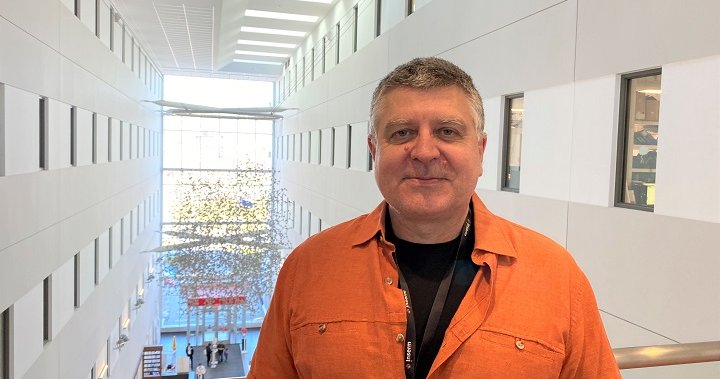Research done in Montreal could lead to treatment for aggressive form of breast cancer | Globalnews.ca
Chances are, someone you know has been or will be affected by breast cancer.
But a recent discovery by a group of Montreal researchers into the genetic mechanisms at play in an aggressive form of the disease known as triple-negative breast cancer is fueling new hope for some of those being impacted by it.
Dr. Jean-Jacques Lebrun and his team at the Research Institute of the McGill University Health Centre not only identified which group of genes play a role in tumour progression but also uncovered what could be a promising therapy.
Lebrun, who has been doing cancer research since he was appointed to McGill some 25 years ago, said the team focused on triple-negative breast cancer or “TNBC” to address what he described as a medical gap.
“There are some breast cancers that can be cured using drugs or surgery, but the triple-negative breast cancer … there’s no efficient, targeted therapies,” he said. “The only recourse we have are usually chemotherapy and radiotherapy.”
Read more:
Montreal mother launches desperate plea for help to access experimental cancer treatment
Existing drugs and therapies target specific proteins, such as estrogen receptors, progesterone receptors or human epidermal growth factor receptors (HER2), which are normally found in breast cancer cells.
For example, those with HER2-positive breast cancer will test positive for the HER-2 protein. Lebrun said a drug called Herceptin can be used to treat those cases.
“It is an antibody that targets that receptor,” he explained, whereas “Tamoxifen — an anti-estrogen therapy — works well for women with hormone receptor-positive breast cancer.
TNBC doesn’t express any of those three proteins, meaning the cells test negative on all three tests, hence the “triple-negative” in the name.
And while TNBC isn’t as common — it makes up only 15 to 20 per cent of all breast cancers — Lebrun says it is by far the deadliest, accounting for half the deaths.
“Mortality rates are very high and the overall survival rates are very short. So people with this disease usually have months to live, not years,” he said.
Changing those outcomes is what motivated Lebrun’s team to take on TNBC.
Read more:
Alberta nurse with terminal breast cancer accepted into U.S. clinical trial
Rather than using a hypothesis-driven approach which would have meant picking a protein and trying to target it, Lebrun said they opted for a systemic approach.
But that meant screening the entire human genome or roughly 20,000 genes.
“We want to know which ones out of those are actually important in the process of tumour formation in those TNBC,” he said.
To do that, scientists used gene-editing technology known as CRISPR, to cut each of the 20,000 genes one-by-one in a process referred to as “silencing” or “knocking out.”
And while it wasn’t quite like searching for a needle in a haystack, Lebrun said it was a painstaking process.
“When we started about five years ago, the technology was there, but just born,” he said of CRISPR. “So what sounds like much easier today to do was a lot more difficult at that time because we had to develop and optimize many of the tools ourselves.”
Read more:
First in-body CRISPR study set to start in U.S. to treat form of blindness
Following analysis, Lebrun said they were able to narrow down their search to around 350 genes, eventually identifying two signalling pathways or gene networks of significance.
“One of them was an oncogenic pathway. Those are genes that normally promote cell proliferation on tumours and this one was hyperactivated in those breast cancer patients,” Lebrun said.
The second group of genes, which normally act as tumour suppressors by preventing cells to multiply, were found to be inactive or asleep.
This combination, Lebrun believes, could explain why TNBC tumours are so “aggressive and metastatic.”

Understanding which genetic mechanisms were involved allowed the team to then uncover existing drugs that targeted those networks.
One of the drugs they tested, Verteporfin, surprisingly had nothing to do with cancer.
“It’s actually a drug that is used for disease of the degeneration of the retina. It’s an eye disease,” Lebrun said.
“When we saw that this drug was able to target the genes that we were interested in, we said, ‘Let’s test that one out for the other network.’”
In all, the team evaluated around 10 different drugs, with Verteporfin being one of two standouts.
“When we tested each drug individually, they both worked,” Lebrun said. “So we were very happy because somehow it was validating our whole strategy, which was to identify the gene, find corresponding drugs and demonstrate that both drugs are working.”
Lebrun’s team was in for a pleasant surprise, however, finding that when combined, the drugs had a much bigger effect than anticipated.
Individually, each drug had around a 20 per cent decrease in tumour growth, so combined, Lebrun said they were expecting around 40 per cent inhibition.
“But we got something more like 80 per cent,” he said. “That’s what we call a synergistic effect.”
Lebrun and his RI-MUHC award-winning team.
Courtesy Jean-Jacques Lebrun
The team’s work hasn’t gone unnoticed.
It was recently awarded Québec Sciences magazine’s prestigious Discovery of the Year Award for 2021.
“It means a lot. … I’m super happy for the team,” Lebrun said. “It’s always nice to have your work recognized. … At least we can say, ‘OK, once I did something that contributed to the health of the population.’”
And while Lebrun is pleased with the accolades, he’s not one to rest on his laurels.
“I think that it’s a significant advancement in the field,” he said. “But you know, when I see it reflected in a clinical trial, then I will be happier.”
Efforts have been underway since the summer to get Phase 1 clinical trials off the ground, but Lebrun says there are many hurdles to overcome.
The first is that trials take time to set up. Lebrun said there’s a lot of administrative work and you also need ethical approval to go ahead.
Then there is the cost of the trial itself.
“It’s complicated because you need sponsors,” Lebrun said. “Even the Phase 1 clinical trial — you need several millions of dollars to start with.”
And that doesn’t include the cost of the drugs themselves, some of which, like Verteporfin, can be extremely expensive to produce, according to Lebrun.
“When you’re going to do that in humans, you need huge quantities of those drugs and that is something that sometimes we don’t think about,” he said, again pointing to the need for partnerships.
And while discussions are underway to that effect, Lebrun said he couldn’t give a timeline of when the trial would start and when patients could begin enrolling.
“But that’s our next step.”
© 2022 Global News, a division of Corus Entertainment Inc.
For all the latest health News Click Here




